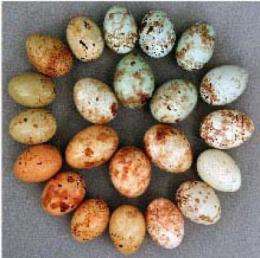Parasite arms race spurs color change in bird eggs

The eggs laid by two African bird species have evolved different color patterns over a period of just 40 years, according to new research published in The American Naturalist. The quick change appears to be driven by an unwanted guest in the nest.
Cuckoo finches are brood parasites. They lay their eggs in the nests of other bird species, hoping to trick someone else into raising their young. To help keep their imposter eggs from being evicted, the cuckoo eggs have evolved to look a lot like those of its most common target, the tawny-flanked prinia. But prinias have evolved a defense. Their eggs have complex patterns of spots and squiggles and can vary substantially in color from female to female. The variable colors and patterns mean the cuckoo eggs aren't always a good match, and prinias can often spot them and toss them out of the nest.
University of Cambridge researchers Claire Spottiswoode and Martin Stevens show that the cuckoo's mimicry—and the prinia's defenses against it—have caused the appearance of both species' eggs to change over time.
In the course of their research in Zambia, Spottiswoode and Stevens noticed that cuckoo and prinia eggs they were seeing in the wild differed markedly from those in a museum collection made at their study site. "For example, 30 years ago, cuckoo finches predominantly laid eggs that look red to our eyes, but now lay mainly blue ones," Stevens said. "Prinias in turn now more commonly lay olive-colored eggs, perhaps to escape their pursuing parasite."
To test these observations, the researchers used computer models that quantified changes on spot pattern and color in past and present eggs. Their models were calibrated to view the eggs through a bird's eyes, which are better than ours at seeing colors and distinguishing ultraviolet light.
The models confirmed the observation. The eggs are changing colors, and fast. The changes detected in this study happened over the course of just 40 years, a period "that is a mere blink of an evolutionary eye," Stevens said.
The research offers a prime example of an evolutionary arms race between parasite and host, the researchers say. The dominant color pattern of prinia eggs serves as a good defense only until the cuckoos catch up. At that point, natural selection should begin favor prinias that lay eggs with new colors, which make the cuckoo eggs stand out. In effect, the two species appear to be locked in a perpetual race around the color specrum.
"Just as humans need to invent new drugs to defeat evolving bacteria and viruses, so host defenses undergo rapid changes to evade cuckoos," Spottiswoode said.
More information: Claire N. Spottiswoode, Martin Stevens, "Host-Parasite Arms Races and Rapid Changes in Bird Egg Appearance." The American Naturalist 179:5 (May 2012).
Provided by University of Chicago















